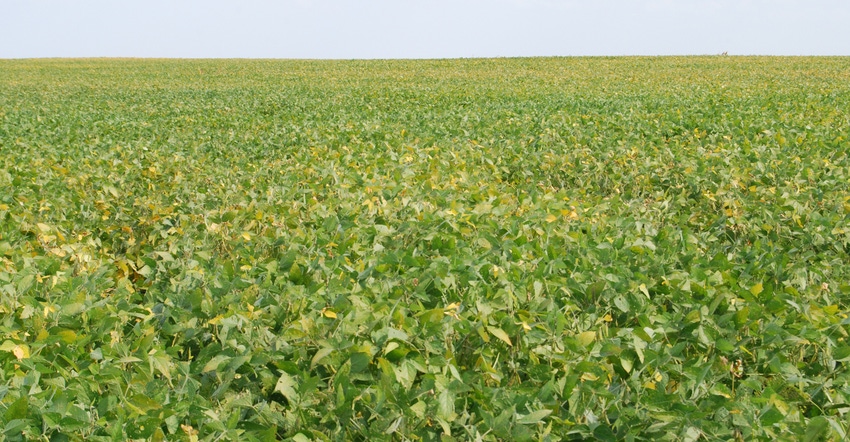September 11, 2018

As harvest approaches, Iowa State University Extension economist Chad Hart is urging farmers to watch their costs and be patient as they face an uncertain market and low profit margins for corn and soybeans. That’s the message he delivered as he spoke at the ISU exhibit at the recent 2018 Farm Progress Show at Boone.
“This marketing year, like many of the previous years, will challenge producers’ patience and financial standing,” Hart says. “It will take some time for prices to recover, and we may not yet have seen the low. But time is still on our side if we can position ourselves to ride out the next few months. Seasonal patterns and the current futures prices both suggest better crop prices will be available in the spring.”
Re-examine crop marketing, storage
In the meantime, farmers need to control costs as best as they can, be patient and use marketing strategies to take advantage of price rallies, he says. Many farmers use storage as it achieves two of these three objectives, but it makes sense this year also to re-examine their approaches to crop marketing and storage.
“Storage is never free; there are always interest and opportunity costs,” Hart says. “Each year farmers should evaluate the relative benefits of owning the crop physically versus re-owning the crop, either by futures and/or call options.”
Prices for grain were about breakeven when the year started and improved until trade tariffs started to be enforced and crop ratings exceeded expectations, driving projected returns into negative territory. Hart says some recovery has occurred and could resume, as the trade markets shift such as increasing crop shipments to North Africa.
Dealing with negative profit margins
“For the farmers who took advantage of this spring’s marketing opportunities, congratulations,” says the ISU Extension crop marketing specialist. “Those sales look exceptional now, and they should make the rest of the year easier to get through. Looking forward, the keys to marketing this year are roughly the same as those for previous few years, since we have once again returned to negative margin projections.”
After release of the August USDA report, projected Iowa corn returns were hovering just below breakeven, while soybean returns remain well below zero. Both crops face large potential supplies, but soybeans are much more vulnerable to the trade tensions brought on by the controversy over tariffs.
“Any recovery will likely look like the past couple of months — two steps forward, followed by one step back — as the harvest plays out and trade routes readjust to the new pricing and tariff environment,” Hart says.
Record soybean crop on the horizon
A record U.S. soybean crop seems nearly certain, according to farmers visiting the Iowa Soybean Association tent at the Farm Progress Show in late August.
Despite a slow start to planting in northern Iowa last spring, and drought conditions in southeast and south-central Iowa this summer, late-season rains and recent crop conditions support a prediction for high bean yields.
Soybean crop predictions for 2018 by ProFarmer Midwest Crop Tour exceed the previous record soybean production forecast that USDA released earlier in August. ProFarmer now predicts the U.S. bean yield to average 53 bushels per acre (63.5 bushels per acre in Iowa), bringing the 2018 U.S. soybean crop forecast to 4.68 billion bushels.
In its August crop report, based on conditions as of Aug. 1, USDA predicted a 51.6-bushel-per-acre national yield average for soybeans, up 2.5 bushels from last year. USDA estimated Iowa's soybean yield at 59 bushels per acre, up 2.5 bushels from last year. With this year’s higher yield estimate, U.S. soybean production is set to top 4.5 billion bushels for the first time.
Corn yield estimates may be too high
When it comes to corn, farmers who gathered in the Iowa Soybean Association tent at Farm Progress Show in late August thought the August estimates for this year’s crop could be a little high. The ProFarmer Crop Tour estimated an average of 202.0 bushels per acre in Iowa, noting that in parts of the state, growing conditions this year were either too wet or too dry, and final corn yields would likely be lower.
The USDA report released earlier in August estimated the national average yield for corn to be 178.4 bushels per acre this year. That would be up 1.8 bushels from last year’s record-high national average yield. USDA’s August estimate projects the third-largest U.S. corn crop in history, at 14.6 billion bushels, down less than 1% from last year’s harvest.
The higher corn yield estimates — both by USDA and by ProFarmer — "are not really in line with what I’ve been hearing in some of my travels across the Midwest,” says ISA Director Tim Bardole, who farms in Greene County in west-central Iowa. He cites this year’s challenging weather conditions and disease infestations as reasons why.
Yield forecast to be updated Sept. 12
According to a review from Iowa State University, since 2001, the ProFarmer Midwest Crop Tour results have steadily become more accurate over the years. For corn, results collected annually since 2001 are, on average, 6.1 bushels per acre above USDA’s final estimates released each January for the seven states where ProFarmer’s crop tour takes place. USDA will update 2018 corn and soybean crop projections on Sept. 12, when it releases its September crop report.
You May Also Like




